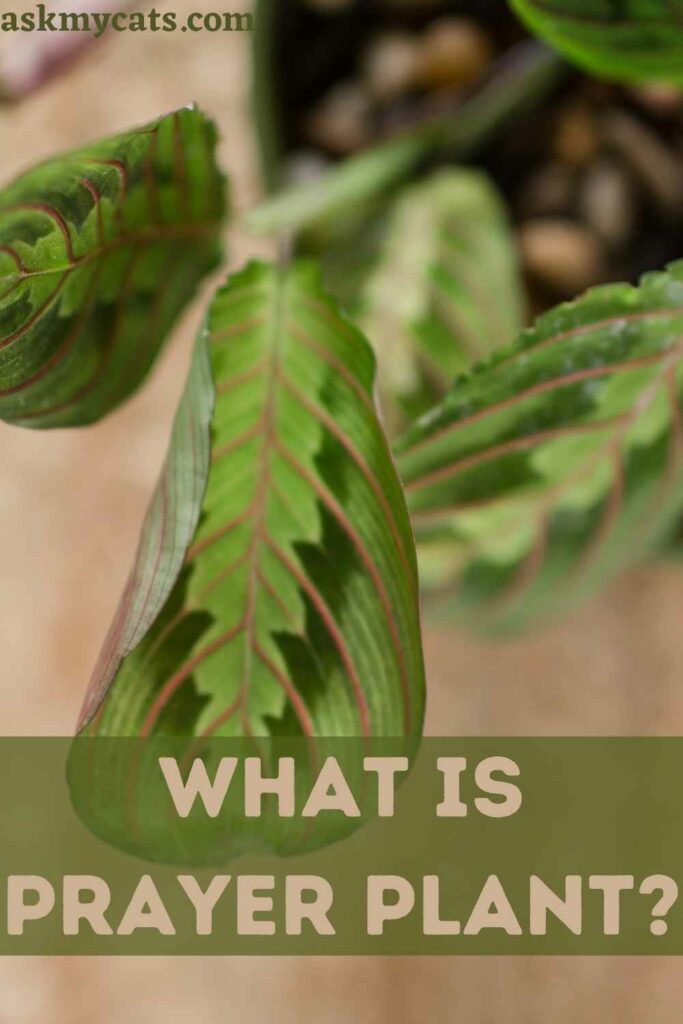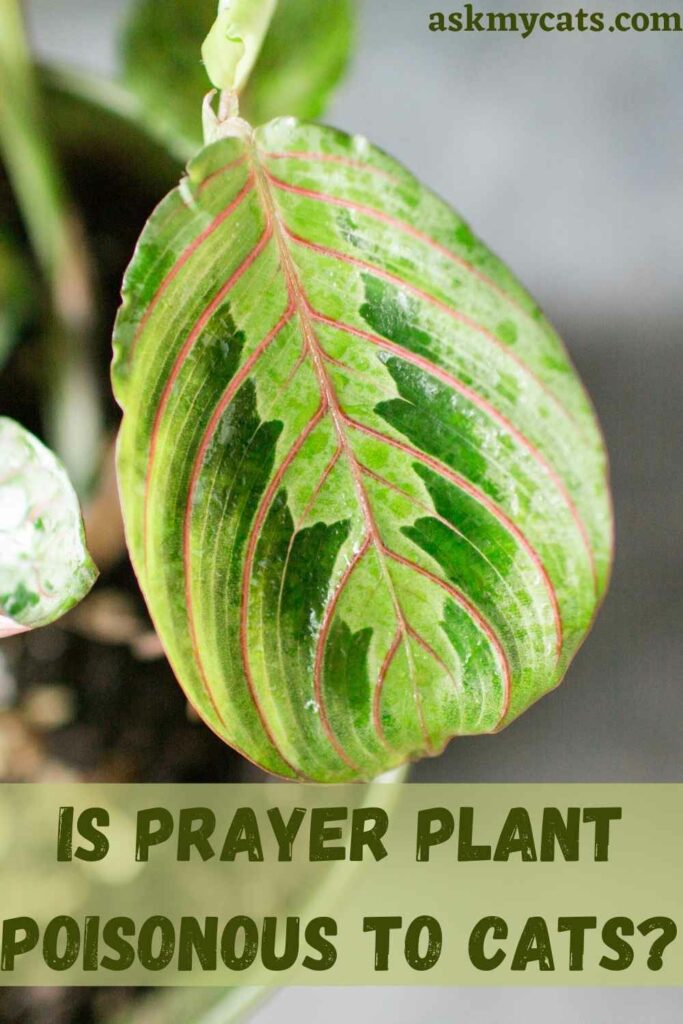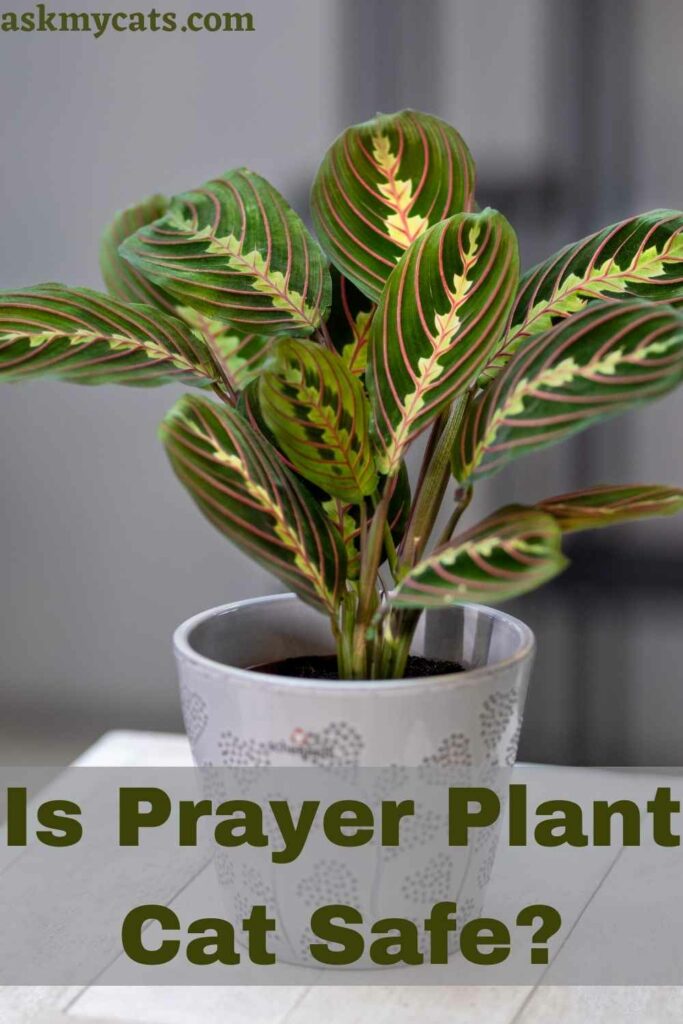Sure, prayer plants have lovely broad leaves with various green tones, but here’s what makes them truly unique: The leaves fold together as though in prayer at dusk. With the first rays of sunlight, they reopen, sometimes with a subtle rustle. Prayer plants (also known as Maranta) take special attention, but once they do, they are cheerful and attractive additions to your plant collection.
However, is the prayer plant toxic to cats?
No, the prayer plant is not toxic to cats. The prayer plant is non-toxic to cats and dogs, according to the Central District of Health Department, and it has been added to the list of safe plants. Prayer plants grow best in hanging pots, so putting them there will also protect your plant from your pet’s damage. In the event of an emergency, call pet care for more information.
This article will talk about the relationship between prayer plants and cats.


Give Your Cat the Perfect Day
Get the Free Ebook!
What is Prayer Plant?
Prayer Plants feature unique foliage with feathered, painterly-like veins. The bold foliage makes Prayer Plants perfect for window sills, mantles, or shelves that need a splash of colour.

The prayer plant, also known as Maranta leuconeura, is a flowering plant in the Marantaceae family that is native to the Brazilian tropical forests.
It is a rhizomatous perennial that grows to 30 cm (12 in) tall and wide, with crowded clumps of evergreen, highly patterned oval leaves up to 12 cm (5 in) long.
The specific name leuconeura refers to the leaves, which are white-veined.
The leaves lie flat during the day and fold in an erect position at night, as if in prayer for evening vespers, earning it the common name “prayer plant.” A diurnal regularity can be seen in this behaviour.
During the growing season, small white flowers bloom, albeit this is uncommon in houseplants, and the flowers are of little value in comparison to the lovely foliage.
The plant’s large leaves are round, two-toned, greenish, and quite glossy. On both sides of the leaf medium, there are dots whose colour changes depending on the cultivar.
Light green, green, brownish-grey, or dark grey patches are possible. The colour of the medium varies depending on the kind.
The colour of the undersides of the leaves varies from light green in M. leuconeura var. kerchoveana to a deep red in M. leuconeura var. erythroneura. The roots are very shallow.
In temperate climates, the prayer plant is a well-known houseplant that requires a minimum temperature of 15 °C (59 °F).
Prayer plant loves bright indirect sunlight, high humidity, and well-drained soil with a high humus content, as it is a rainforest native. Soils that are acidic, clay-based, or loam-based can be tolerated.
Direct sunshine, as well as standing water, should be avoided. The optimal temperature is 21–27°C during the day and 16–21°C at night; the night temperature should not drop below 15°C. Higher temperatures necessitate higher humidity levels, which can be achieved by simply spraying.
Is Prayer Plant Poisonous To Cats?
No, prayer plant is not poisonous to cats.

If you want to know if prayer plants are poisonous to cats, you should first know that they have gorgeous pattern leaves and unique layers of shades.
The most astonishing and fascinating feature about this plant is that it can stand up at night or in the dark, yet it seems flat and sleeps during the day when there is light.
It was a one-of-a-kind occurrence I’ve never seen in any plant; it was well-known not only for its leaves but also for the motions it made at all hours of the day and night.
According to the Central District of Health Department, prayer plants are non-toxic to cats and dogs and have been included in the list of safe plants, which includes velvet, Swedish ivy, dracaena, and jade plants.
Prayer plants grow best in hanging pots, so putting them there will also protect your plant from your pet’s damage. In the event of an emergency, call pet care for more information.
Prayer plant is a perennial plant with elliptical-shaped leaves that grows to a height of 9-12 inches or more.
If you set this houseplant in direct sunlight, it will not thrive, and if you give it a lot of water every day, it will rot.
The best temperature for thriving during the day is 22 to 26 degrees Celsius, whereas the best temperature for thriving at night is 15 to 20 degrees Celsius.
Maranta plants are not poisonous to cats or dogs because this is the scientific term for a prayer plant, and they are classified as harmless plants.
Usually grown in a balcony with a hanging pot and requires adequate fertilizer soil; otherwise, fertilizer will be required in the summer or spring.
The ASPCA’s largest website of plants and animals, and is safer indoors, but be cautious if there is a pet that spoils everything.
Cat owners must provide regular care and cleaning in order to keep their pets healthy. This is a flowering plant with a lovely blue tint to its foliage.
This means that if you work from home and have a cat, you may use a prayer plant as an office plant and reap the benefits of working with houseplants while still being surrounded by beautiful evergreen foliage.
Because the prayer plant contains no hazardous or irritating compounds, your cat will not be harmed by eating, rubbing on, or otherwise engaging with it. Calathea is non-toxic to both cats and people, according to the USDA.
The only thing that will be harmed by your cat biting your plant to a skeleton is the beauty of your plant.
Because it is neither toxic, poisonous, nor hazardous to animals, the prayer plant does not hurt cats, dogs, or horses.
It is not dangerous, but if your cat eats a lot of its leaves, it can cause stomach problems.
These species, on the other hand, eat only a modest amount of grass on a regular basis. As a result, you shouldn’t be startled if you see your cat eating it.
Prayer plant is absolutely non-toxic to cats, according to the American Society for the Prevention of Cruelty to Animals.
This indicates that none of the plant’s parts, such as the leaves, stems, trunk, or roots, contain any substances that could damage your cat.
Is Prayer Plant Cat Safe?
Yes, the prayer plant is cat safe.

The Prayer plant is a lovely, non-toxic plant that your cats will enjoy.
The Prayer Plant, also known as Maranta leuconeura, is native to the tropical woods of Central and South America.
It thrives in humid climates with temperatures ranging from 60 to 80 degrees Fahrenheit.
Cathedral Windows, Herringbone Plants, and Rabbit Tracks are all names for prayer-plants.
During the day, their oval-shaped leaves are limp, but at night, they lift, resembling praying hands. The leaves have yellow splotches and red veins and are green in colour.
Because of their attractive look and modest size, they are commonly kept as houseplants.
Some pet owners believe that multicoloured houseplants are more poisonous than green houseplants.
The crimson veins on the leaves of the Prayer Plant may give the idea that it is poisonous, but it is not.
Touching or consuming the leaves, roots, or blossoms of this non-toxic plant will not affect cats, dogs, or people.
One of the plant species that has been proved to be safe for both cats and humans is the prayer plant.
You can keep them at home to add to the aesthetic appeal of the space. At the same time, you can incorporate it into your family’s garden.
Cats are not poisoned by the prayer plant. Cats, on the other hand, may have harmed your prayer plant. Unlike Cyclamen, the prayer plant does not contain any harmful chemicals.
Your cat will have no trouble nibbling on the leaves of the prayer plant. Furthermore, your cat could rip the leaves off, destroying them.
Although the prayer plant is unlikely to harm your cat, it is possible that your cat will become hostile in its presence. Cats are irrational creatures. Its claws have the ability to remove the leaves from the plant and scratch it.
What Varieties Of Prayer Plant Is Safe For Cats?
All varieties of prayer plants are safe for cats.
Prayer plants come in a variety of colours and patterns, which distinguish them from one another. One of the most remarkable examples is red prayer plants, which have beautiful crimson veins running across them.
Lemon (or lemon limes) have veins that are pale green/white instead of crimson. The olive green base of the black variation features silver patterns and veins, as well as purple dots.
Green and Kim prayer plants have fewer veins and are known for their huge spots, which are either green (in the past) or a deep, dark purple (the latter).
All of these varieties are considered safe for cats as per ASPCA.
How To Keep Cats Away From Prayer Plant?
You can keep cats away from prayer plant by following one of these steps: –
1. Use Rocks
Covering the dirt around your prayer plant with pebbles will deter your cat from digging while also allowing water to pass through the rocks, making it easier to water the plants.
2. Use Oranges
Because cats loathe the smell of citrus, a circle of orange peels around your prayer plant can act as a barrier to keep your cat at far.
3. Get A Plant Your Cat Won’t Like
Rosemary is a highly scented shrub, hence cats aren’t fond of it. They’re also lovely and will keep your home smelling wonderful!
4. Alternative Plant
On the other hand, instead of acquiring other plants that could be toxic to your cat, you could invest in plants like barley or catnip that your cat will enjoy eating. Mint and sesame are also popular among cats.
5. Try Tape
Because cats loathe sticky objects, a coating of double-stick tape wrapped across the lip of each prayer plant’s pot will help keep their paws away.
6. Cover The Plant
If all else fails, you can always use chicken wire to make barriers around your prayer plant or use plants in terrariums that your cat won’t be able to get into.
7. Keep Them Distracted
Providing your cat with a variety of toys to distract them is an excellent method to stop this behaviour.
Setting up fishing pole toys on a counter for them to play with could keep them from getting their claws into something important to you.
Frequently Asked Questions
What are the symptoms of a cat eating a lot of prayer-plants?
Poisoning symptoms include oral irritation or burning, excessive drooling, vomiting, and difficulty swallowing. Contact your veterinarian right away if your cat exhibits these symptoms after eating portions of a similar-looking plant. The prayer plant is a beautiful, non-toxic houseplant that is safe to maintain around your cats.
How much light does the prayer plant require?
While prayer-plants may survive in low light, they prefer bright, indirect light. They dislike being in direct sunlight. Too much light can bleach the leaves of your prayer plant, so if your plant’s leaves start to seem washed out, try relocating it to a lower light setting. On the other side, if there isn’t enough light, your prayer plant’s leaves won’t fully open in the morning, so keep an eye out for this sign.
Is prayer plant toxic to humans?
Prayer plants are not toxic to cats or dogs, but many people are curious if they are poisonous to humans. The answer is that it is not toxic and has no adverse effects, but you should still be cautious and keep them out of reach of children.
Final Words
Cats normally have control over how much food they eat or nibble, however, some cats may not have control over how much prayer plant leaves they eat. Although it is non-toxic to cats, if your cat consumes a significant amount of it, it may cause a small GI upset.
If your cat consumes a large amount of this plant, he or she may develop an intestinal blockage. Due to how tempting this plant is to some cats, you may need to restrict access to it.
If you have any questions, ask us in the comments section.
